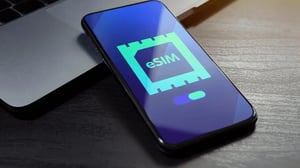We all know what a “SIM card” is since it’s nearly impossible to make and receive calls without one, but lately, there’s been a new kind of technology making headway: eSIM. For most, this term might not hold a lot of meaning since not all smartphones support eSIM technology yet. However, this new technology is breaking into the smartphone space in a big way. In September, the iPhone 14 launched, with the US model only accepting eSIMs–there isn’t even a SIM slot on the new model!
Now that the transition to eSIM is becoming more urgent, let’s go through what exactly an eSIM is, how it’s different from a standard SIM card, and what the advantages and disadvantages of eSIM are.
What is a SIM card?
First, let’s do a quick run-through of the traditional SIM. A SIM card is a Subscriber Identity Module. It’s inserted into a special tray built into your smartphone. Usually, we get a SIM card from our mobile carrier with pre-installed account information (phone number and security keys for identification in the carrier’s network). SIM cards come in four sizes: standard, mini, micro, and nano. One of the advantages of a SIM card, and the reason they’re still so common, is the ability to remove it from one device and insert it into another.
What is an eSIM?
Simply put, an eSIM is a virtual SIM card. eSIMs are built into a mobile phone (the letter "e" means "embedded"). While it’s not possible to remove and relocate an eSIM like you can with a physical SIM, you can overwrite it remotely.
eSIMs also have significantly more memory with 512KB, compared to standard SIM cards which have 128-256KB. With this kind of memory, multiple mobile carriers can be recorded on as eSIM making them easy to connect. They’re also easy to activate, your carrier will send over a QR code that can be scanned by your phone’s camera.
Benefits of an eSIM
- You can install up to 5 numbers.
-
Have more than one SIM: Newer phones offer dual-SIM technology that allows users to have one physical SIM and one eSIM on their devices.
Having two numbers on one device opens a new world of possibilities for those used to operating two phones for work and personal use. Users can receive phone calls and texts like normal on both numbers, and also choose which SIM to use for making calls, sending texts, and using cellular data.
- You don’t need to request a physical SIM card from your carrier, everything can be done online from your account in a matter of minutes and you can easily switch networks.
- You only need to scan the QR code to activate the SIM
- Before traveling to another country, you can choose a local operator in advance and arrange for an eSIM with a local number
- They’re impossible to lose since they’re embedded into your device!
-
Use less space: Removing a physical SIM card allows for less physical space to be used on future devices like cellphones and wearable devices. Devices like Apple Watches and other smartwatches have already taken advantage of eSIM technology to promote a slimmer and more convenient design for everyday use.
-
Ideal for IoT devices: Given eSIMs ability to be easily updated and deployed, this technology is key to keeping IoT devices connected. New lines can be opened up remotely as needed and for users all over the world! Businesses can also manage eSIM-enabled devices easily on one contract as opposed to juggling multiple contracts and network operators.
Disadvantages of an eSIM
- While there are a number of advantages that eSIMs have over physical SIM cards, there are still a few drawbacks to this technology.
- eSIM technology still isn’t widespread, so not all carriers support it
- Not all phone models have eSIM capabilities
- If your phone is broken or you bought a new one, you can’t move the SIM from one device to another. You’ll need to contact your carrier for a new QR code.
Our eSIM Capabilities
For global deployments, eSIMs are not only ideal, but they’re becoming a necessity. It’s getting increasingly difficult for companies to use physical SIMs globally and stay updated with the local regulations of other countries. With eSIM, your company can “re-write” the eSIM as needed to stay in line with local regulations, making them future-proof.
POND offers full support for eSIM technology across 200+ countries worldwide and 800+ networks on one digital SIM .

